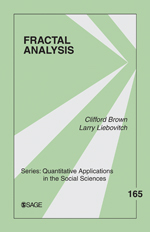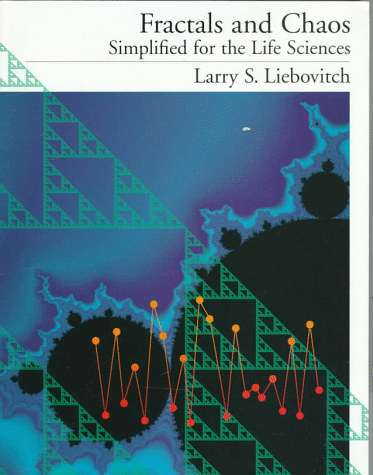It is well to read everything of something, and something of everything.
Emeritus Faculty

Dynamics of Molecular/Psychological systems
B.S. Physics, City College of New York, 1972
Ph.D. Astronomy, Harvard University, 1978
Ph.D. Astronomy, Harvard University, 1978
Personal Webpage
In 1995, elected as a Fellow of the American Physical Society
"For advancing the physics of fractals and chaos and using these methods to analyze and understand biological systems."
Dean of the Division of Mathematics and Natural Sciences 2010-2013. Accomplishments as Dean, Curriculum Vitae, Resume (1-page)
Article about Dr. Liebovitch from Emerging: The Newsletter of the Plexus Institute (July/August 2005)
En espanol - from number 21 of "Komplex", a monthly newsletter edited by O+berri, the Basque Institute of Innovation (29 de mayo de 2006)
In 1995, elected as a Fellow of the American Physical Society
"For advancing the physics of fractals and chaos and using these methods to analyze and understand biological systems."
Dean of the Division of Mathematics and Natural Sciences 2010-2013. Accomplishments as Dean, Curriculum Vitae, Resume (1-page)
Article about Dr. Liebovitch from Emerging: The Newsletter of the Plexus Institute (July/August 2005)
En espanol - from number 21 of "Komplex", a monthly newsletter edited by O+berri, the Basque Institute of Innovation (29 de mayo de 2006)
The analysis of complex systems that have many interacting parts.
PEOPLE: Models of Conflict
We are applying concepts from the dynamics of physical systems to model the interactions between two or more people and then, as part of a team of social scientists, using social psychology laboratory experiments to test the predictions of those models. Liebovitch et al., 2008, Physica A387:6360-6378
GENES: Differentiation of Blood Stem Cells
We are using mathematical models of the interaction of genes (such as GATA1 and PU.1) to predict how changes in the levels of signaling proteins and gene expression lead to different cell fates from progenitor blood stem cells. These predictions will be tested by experiments to be done at the Institute for Stem Cell Research at the Helmholtz Center Munich, Germany.
DRUGS: Turning Deleterious Drug Interactions Into Useful Multidrug Therapies
Drugs designed for a specific target are always found to have multiple effects. We are exploring how to use computational methods to predict which combinations of drugs, whose effects interfere with each other, in just the right way, to produce more targeted results with fewer side effects. Liebovitch et al., 2007, Nonlinear Biomedical Physics, 1:11..
EPIDEMICS: Spread of Infectious Diseases
We are modeling the spatial and temporal transmission of infectious agents through geographically distributed "patches" of people. These models give insight into how diseases spread in response to natural and human created events. Rho et al., 2008, Phys. Letts. A372:5017-5025.
ECONOMICS: Econophysics
We are analyzing the prices of commodities from ancient Babylon and medieval England to determine if ancient economies functioned as supply and demand systems, like modern economies. The challenge here is how to analyze time series data when there are gaps of 70% to 95% in the data. Europhysics Letters 90:18004.
ARCHEOLOGY: Movements of People and the Spatial Distribution of their Artifacts
We are using new methods, based on fractals, to analyze and understand the migration patterns of people and the spatial distribution of their artifacts at archeological sites. Brown et al., 2005, J. Archaeological Method and Theory 12:37-78.
Fractals and Chaos Simplified for the Life Sciences
- by Larry S. Liebovitch
- Oxford University Press, New York NY, 1998
- ISBN 0-19-512024-8
- This book explains the properties of fractals and chaos and illustrates them with examples from biology and medicine. The aim is to provide a basic understanding to people who are unfamiliar and/or afraid of mathematics. However, enough mathematical detail is provided so that biomedical scientists can learn how to use these new methods in their own research. The material is presented one concept at at time on facing pages, with text on the left page and graphics on the right page. The graphics pages can be copied onto transparencies to use to teach this material.
Nonlinear Biomedical Physics

- New on-line journal of nonlinear methods from the physical sciences applied to biology and medicine.
- Articles that cross the cultural divide from mathematics to the life sciences.
- Editors-in-Chief: Zbigniew CZERNICKI, Wlodzimierz KLONOWSKI, and Larry LIEBOVITCH
Fractal Analysis in the Social Sciences

SAGE Publications, Quantitative Applications in the Social Sciences, Volume 165
SAGE: QASS Vol. 165
SAGE: QASS Vol. 165
- by Clifford T. Brown and Larry S. Liebovitch
- SAGE Publications, Thousand Oaks, CA, 91320
- ISBN: 9781412971652
- This primer uses straightforward language to give the reader step-by-step instructions for identifying and analyzing fractal patterns and the social process that create them. By making fractals accessible to the social science students, this book has a significant impact on the understanding of human behavior.
- Detailed examples help readers learn and understand the analytical methods presented.
- Clear and logical explanations of fractals and their analysis enable the instructor to easily teach and the student to easily learn the material.
- MATLAB programs to analyze data.
Attracted to Conflict: Dynamic Foundations of Destructive Social Relations

- R. R. Vallacher
- P. T. Coleman
- A. Nowak
- L. Bui-Wrzosinska
- L. Liebovitch
- K. Kugler
- A. Bartoli
- Springer, New York, NY, 10013
- ISBN: 978-3-642-35279-9
- Addresses intractable social conflict from the new vantage point of dynamical systems.
- Authored by leading researchers in the field with different relevant backgrounds.
- Addresses a broad audience of researchers in the natural sciences and humanities.
- L. S. Liebovitch, Y. Tao, A. T. Todorov, and L. Levine. 1996.
- Is there an error checking code in the base sequence in DNA? Biophysical Journal, 71:1539-1544 (pdf)
- L. S. Liebovitch, A. T. Todorov, M. Zochowski, D. Scheurle, L. Colgin, M. A. Wood, K. A. Ellenbogen, J. M. Herre, and R. C. Bernstein. 1999.
Nonlinear properties of cardiac rhythm abnormalities. Phys. Rev E, 59:3312-3319. (pdf) - M. Zochowski and L. S. Liebovitch. 1999.
Self-organizing dynamics of coupled map systems. Phys. Rev E, 59:2830-2837 (pdf). - S. B. Lowen, L. S. Liebovitch, and J. A. White. 1999.
Fractal ion-channel behavior generates fractal firing patterns in neuronal models. Phys. Rev E, 59: 5970-5980 (pdf) - M. A. Wood, K. A. Ellenbogen and L. S. Liebovitch. 1999.
Electrical storm in patients with transverse implantable cardioverter-defibrillators. J. Am. Coll. Cardiology, 34:950-951. - L. S. Liebovitch, A. T. Todorov, M. A. Wood, and K. A. Ellenbogen. 2000.
When using the mean is meaningless: examples from probability theory and cardiology, In Handbook of Research Design in Mathematics and Science Education, Eds. A. E. Kelly and R. Lesh, Lawrence Erlbaum Assoc. Inc, Mahwah NJ, pp. 913-926. - L. S. Liebovitch, and D. Scheurle. 2000.
Two lessons from fractals and chaos. Complexity, 5(No.4):34-43. (pdf). - L. S. Liebovitch and A. T. Todorov. 2000.
What causes ion channel proteins to open and close? In Disorder Versus Order in Brain Function, Eds. Peter Arhem, Clas Blomberg, and Hans Liljenstrom, World Scientific, River Edge, NJ, pp. 83-106. - W. A. Varanda, L. S. Liebovitch, J. N. Figueira, and R. A. Nogueira. 2000.
Hurst analysis applied to the study of single calcium-activated potassium channel kinetics in Leydig cells. J. Theoret. Biol., 206: 343-353. (pdf). - L. S. Liebovitch, Daniela Scheurle, Marian Rusek, and Michal Zochowski. 2001.
Fractal methods to analyze ion channel kinetics. Methods 24:359-375 (pdf). - L. A. Shehadeh, L. S. Liebovitch, and M. A. Wood. 2002.
Temporal patterns of atrial arrhythmia recurrences in patients with implantable debfibrillators: implications for assessing antiarrhythmic therapies. J. Card. Electrophys.13:303-309. - L. S. Liebovitch and Piotr Krekora. 2002.
The physical basis of ion channel kinetics: the importance of dynamics. Institute for Mathematics and its Applications Volumes in Mathematics and its Applications, Membrane Transport and Renal Physiology, Eds. H. E. Layton and A. M. Weinstein, 129:27-52. (pdf) - L. S. Liebovitch, T. Penzel, and J. W. Kantelhardt. 2002.
Physiological relevance of scaling of heart phenomena. In The Science of Fractal Disasters: Climate Disruptions, Heart Attacks, and Market Crashes, Eds. A. Bunde, J, Kropp, and H. J. Schellnhuber, Springer, Berlin, pp. 258-281. - L. S. Liebovitch and I. B. Schwartz. 2003.
Information flow dynamics and timing patterns in the arrival of email viruses. Phys. Rev. E. 68 :017101-1 - 017101-4. (pdf). - L. S. Liebovitch and I. B. Schwartz. 2004.
Migration induced epidemics: Dynamics of Flux-based multipatch models. Phys. Lett. A 332 :256-267. (pdf). - C. T. Brown, W. R. T. Walter, and L. S. Liebovitch. 2005.
The Broken Past: Fractals in Archaeology. J. Archaeological Method and Theory 12 :37-78. (pdf). - L. S. Liebovitch and Lina A. Shehadeh. 2005.
Chapter 5. Introduction to Fractals (pdf). In Tutorials in Contemporary Nonlinear Methods for the Behavorial Sciences Web Book, Eds. M. A. Riley and G. V. Orden, National Science Foundation, Directorate for Social, Behavorial and Economic Sciences, http://www.nsf.gov/sbe/bcs/pac/nmbs/nmbs.jsp - L. A. Shehadeh, L. S. Liebovitch, and V. K. Jirsa. 2006.
Relationship between global structures of genetic networks and mRNA levels measured by cDNA microarrays (pdf). Physica A 364 :297-314. - L. S. Liebovitch. 2006.
Why the eye is round. in Biology of the Eye, Ed. J. Fischbarg. Elsevier, New York, NY, pp. 1-19. - L. S. Liebovitch, V. K. Jirsa, and L. A. Shehadeh. 2006.
Structure of genetic regulatory networks: Evidence for scale free networks (pdf). In Complexus Mundi: Emergent Patterns in Nature, Ed. M. M. Novak, World Scientific, Singapore, pp. 1-8. - L. S. Liebovitch. 2006.
What is "Self-Organization"? (pdf) In Emgering, The Newsletter of the Plexus Institute, April-August 2006, pp. 16-19. - C. T. Brown, L. S. Liebovitch, and R. Glendon. 2007.
Levy flights in Dobe Ju'/hoansi foraging patterns (pdf). Human Ecology 35:129-138. - L. S. Liebovitch, N. Tsinoremas, and A. Pandya. 2007.
Developing combinatorial multi-component therapies (CMCT) of drugs that are more specific and have fewer side effects than traditional one drug therapies (pdf). Nonlinear Biomedical Physics 1:11 (30 August) doi:10.1186/1753-4631-1-1107. - Y.-A. Rho, L. S. Liebovitch, and I. B. Schwartz. 2008.
Dynamical response of multi-patch, flux-based models to the input of infected people: Epidemic response to initiated events (pdf) Physics Letters A 372:5017-5025. doi:10.1016/j.physleta.2008.05.065 - L. S. Liebovitch, V. Naudot, R. Vallacher, A. Nowak, L. Bui-Wrzosinska, and P. Coleman. 2008.
Dynamics of two-actor cooperation-competition conflict models. (pdf) Physica A 387:6360-6378. doi: 10.1016/j.physa.2008.07.020 - N. E. Romero, Q. D. Y. Ma, L. S. Liebovitch, C. T. Brown and P. Ch. Ivanov. 2010.
Correlated walks down the Babylonian markets (pdf) Europhysics Letters (EPL) 90:18004. doi: 10.1209/0295-5075/90/18004. - C. Witkov and L. S. Liebovitch. 2010.
Predicting optimal sweep rates for autoresonance in Duffing-type oscillators: A beat method using Teager-Kaiser instantaneous frequency (pdf). J. Sound and Vibration 329(8):1154-1164. doi:10.1016/j.jsv.2009.10.030 - C. Marr, F. J. Theis, L. S. Liebovitch, and M.-T. Huett. 2010.
Patterns of subnet usage reveal distinct scales of regulation in the transcriptional regulatory network of Escherichia coli (pdf) PLoS Computational Biology 6(7): e1000836. doi:10.1371/journal.pcbi.1000836 - L. S. Liebovitch, R. Vallacher, and J. Michaels. 2010.
Dynamics of cooperation-competition interaction model, Peace and Conflict: The Journal of Peace Psychology, 16(2):175-188. - J. L. Michaels, V. Naudot, and L. S. Liebovitch. 2010.
Dynamic stabilization in the PU1-GATA1 circuit using a model with time-dependent kinetic change Bulletin of Mathematical Biology doi: 10.1007/s11538-010-9615-3 - L. S. Liebovitch and V. Naudot. 2011.
Open problems in the dynamics of the expression of gene interaction networks (pdf), In Frontiers in the Study of Chaotic Dynamical Systems with Open Problems, Ed. Z. Elhadj and J. C. Sprott, World Scientific, Singapore, pp. 219-229. - L. S. Liebovitch, Paul R. Peluso, M. D. Norman, J. Su, and J. M. Gottman. 2011.
Mathematical model of the dynamics of psychotherapy. Cognitive Neurodynamics doi: 10.1007/s11571-011-9157-x - R. Peluso, L. S. Liebovitch, J. M, Gottman, and J. Su. 2012.
A Mathematical Model of Psychotherapy: An Investigation Using Dynamic Non-linear Equations to Model the Therapeutic Relationship. Psychotherapy Research 22(1):40-55, doi: 10.1080/10503307.2011.622314 - A. Rojas-Pachecoa, B. Obregon-Quintanab, L.S. Liebovitch, and L. Guzman-Vargasa. 2013.
Time-delay effects on dynamics of a two-actor conflict model. Physica A 392:458-467, doi: dx.doi.org/10.1016/j.physa.2012.09.021 - L. Kurt, K. G. Kugler, P. T. Coleman, and L. S. Liebovitch. 2013.
Behavioral and emotional dynamics of two people struggling to reach a consensus about a topic on which they disagree. PLOS ONE in press, accepted 11/15/2013.


